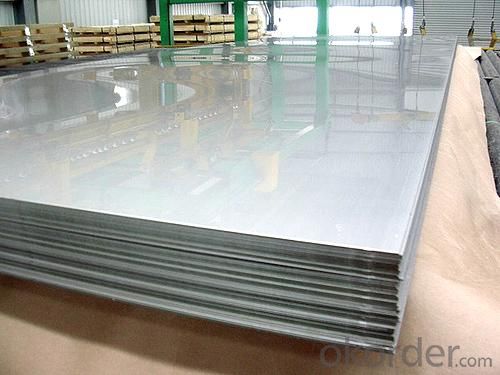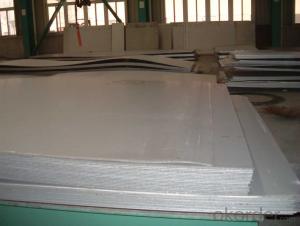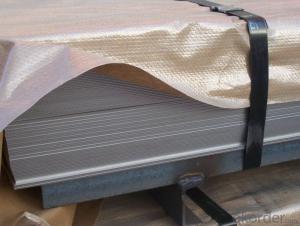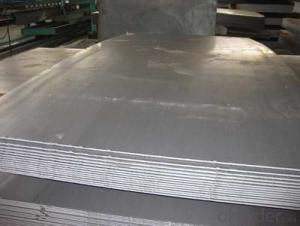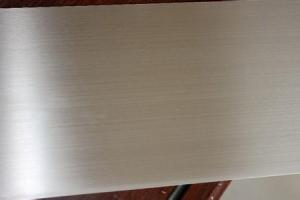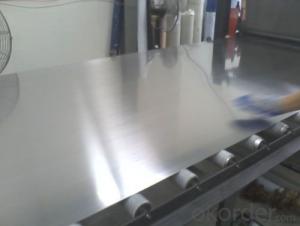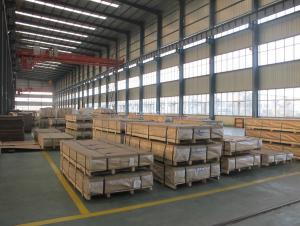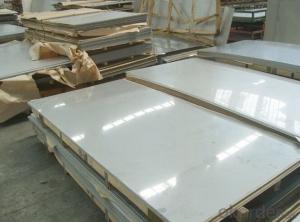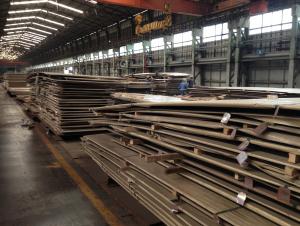Stainless Steel Sheet /Plate
- Loading Port:
- China Main Port
- Payment Terms:
- TT OR LC
- Min Order Qty:
- -
- Supply Capability:
- -
OKorder Service Pledge
OKorder Financial Service
You Might Also Like
Specifications
Stainless Steel Sheet/PlateGrade:201/304
Surface:2B,BA,SATIN
Good Prices With Prime Quality
Item | stainless steel sheet(Hot rolled,cold rolled) |
Standard | ASTM A240,GB/T3280-2007,JIS4304-2005,ASTM A167,EN10088-2-2005,etc |
Material | 201/304 |
Surface | 2B,2D,BA,NO.1,NO.4,NO.8,8K,mirror,etc |
Thickness | 0.5-4.0mm |
Width | 1000mm,1219mm,1500mm,1800mm,2000mm,2500mm,3000mm,3500mm,etc |
Length | 2000mm,2440mm,3000mm,5800mm,6000mm,etc |
Package | Standard export package,suit for all kinds of transport,or as required. |
Price term | Ex-Work,FOB,CNF,CFR,CIF,FCA,DDP,DDU,etc |
Payment term | TT,L/C,western Union |
Export to | Singapore,Indonesia,Ukraine,Saudi Arabia,Spain,Canada,USA,Brazil,Thailand,Korea,Iran, India,Egypt,Oman,Malaysia,Bangladesh,Dubai,Viet Nam,Kuwait,Peru,Mexico,Russia,etc |
MOQ | 5000Kg |
Application | Stainless steel plate applies to construction field, ships building industry, petroleum,chemical industries, war and electricity industries, food processing and medical industry, boiler heat exchanger, machinery and hardware fields.Stainless steel plate can be made according to the customers requirements. |
- Q: Can stainless steel sheets be used for automotive exhaust systems?
- Indeed, automotive exhaust systems can utilize stainless steel sheets. The use of stainless steel is prevalent in exhaust systems owing to its remarkable resistance to corrosion, ability to withstand high temperatures, and durability. It successfully endures the harsh conditions present in exhaust systems, encompassing intense heat, moisture, and chemicals. Stainless steel sheets can be shaped and manufactured into diverse components of the exhaust system, including pipes, mufflers, and catalytic converters. They offer enduring performance, minimize the likelihood of rust and corrosion, and enhance the overall efficiency and longevity of the automotive exhaust system.
- Q: What are the different surface patterns available for stainless steel sheets?
- There are several different surface patterns available for stainless steel sheets, each offering unique aesthetic appeal and functional properties. One popular option is the brushed finish, which is achieved by brushing the surface of the stainless steel sheet with a fine abrasive material. This creates a visually appealing pattern of parallel lines, giving the sheet a sophisticated and elegant look. The brushed finish also helps to hide scratches and fingerprints, making it a practical choice for applications where appearance is important. Another common surface pattern is the mirror finish, which is achieved by polishing the stainless steel sheet to a highly reflective and glossy surface. This finish is often used in architectural and decorative applications where a sleek and luxurious appearance is desired. The mirror finish also has the advantage of being easy to clean and maintain. Embossed or textured patterns are also available for stainless steel sheets. These patterns are created by stamping or rolling the sheet with a specific design, resulting in raised or recessed areas on the surface. This not only adds visual interest to the sheet but also enhances its grip and resistance to slipping, making it suitable for applications such as flooring or industrial equipment. Additionally, there are perforated stainless steel sheets that feature a pattern of small holes or slots. These sheets are commonly used for architectural purposes, such as decorative screens or facades, as well as for filtration or ventilation applications. The perforations can be made in various shapes and sizes, allowing for customization based on specific requirements. Overall, the choice of surface pattern for stainless steel sheets depends on the desired appearance, functionality, and application. Whether it's the sleek and refined brushed or mirror finish, the textured and resilient embossed patterns, or the versatile perforated sheets, there is a wide range of options available to suit different needs.
- Q: Are stainless steel sheets suitable for automotive applications?
- Stainless steel sheets are indeed well-suited for automotive applications. With its durability, strength, and corrosion resistance, stainless steel proves to be an ideal material for various automotive components. It finds extensive use in body panels, exhaust systems, trim, and other parts that necessitate resistance to weathering, heat, and chemical exposure. Moreover, stainless steel sheets offer remarkable aesthetic appeal as they can be polished to a mirror-like finish or brushed to achieve a sleek and contemporary appearance. Additionally, stainless steel is easily malleable, enabling the production of intricate shapes and designs crucial in the automotive manufacturing process. All in all, stainless steel sheets provide the essential properties and versatility to fulfill the demanding requirements of automotive applications.
- Q: What is the difference between stainless steel sheets and plates?
- Stainless steel sheets and plates, widely utilized across various industries and applications, possess distinct dissimilarities. Firstly, concerning thickness, sheets are generally thinner compared to plates. Sheets typically range from 0.4mm to 4mm, whereas plates commence at 4mm and extend to several inches. Secondly, their sizes differ. Sheets are commonly available in standard dimensions of 4ft x 8ft or 5ft x 10ft, while plates usually come in larger sizes and can be tailored to specific measurements. Plates are commonly employed in heavy-duty applications, necessitating enhanced strength and durability. Thirdly, weight plays a role in distinguishing the two. Due to the variance in thickness, plates generally possess greater weight than sheets. This characteristic renders plates more suitable for weight-bearing applications, such as construction, shipbuilding, or industrial equipment. Fourthly, the applications of sheets and plates differ. Stainless steel sheets are often employed for decorative purposes, architectural applications, and smaller-scale projects like kitchen backsplashes or countertops. Conversely, plates are favored for structural components, machinery parts, and load-bearing applications, like bridges, tanks, or pressure vessels. Lastly, cost distinguishes sheets from plates. Stainless steel plates are typically more expensive than sheets due to their larger size and increased thickness. Sheets, being thinner and smaller, are usually more cost-effective and readily accessible. In summary, the key distinctions between stainless steel sheets and plates encompass their thickness, size, weight, applications, and cost. It is imperative to consider these factors when selecting the appropriate material for a specific project or application.
- Q: What are the different types of surface treatments for stainless steel sheets?
- There are several types of surface treatments for stainless steel sheets, including brushing, grinding, polishing, and coating. Brushing creates a textured finish, grinding removes imperfections, polishing enhances shine, and coating adds a layer of protection.
- Q: How do I prevent corrosion under insulation on stainless steel sheets?
- To prevent corrosion under insulation on stainless steel sheets, it is essential to ensure proper installation and maintenance. Firstly, use high-quality insulation materials that are resistant to moisture and have a vapor barrier to prevent any water penetration. Secondly, ensure that the stainless steel sheets are installed correctly, with no gaps or exposed areas that could allow moisture accumulation. Regular inspections and maintenance, including repairing damaged insulation or sealing any gaps, are crucial to prevent moisture ingress. Additionally, applying a suitable corrosion inhibitor on the stainless steel surface can provide an extra layer of protection.
- Q: Can stainless steel sheets be used for conveyor systems?
- Certainly! Conveyor systems can indeed utilize stainless steel sheets. Stainless steel is a highly durable and sturdy substance that possesses excellent resistance against corrosion. This exceptional quality makes it the perfect choice for conveyor systems that may come into contact with moisture or harsh chemicals. Moreover, stainless steel is effortless to clean and maintain, which is crucial for ensuring the hygiene and longevity of conveyor systems in industries such as food processing or pharmaceuticals. The sleek surface of stainless steel sheets also aids in the smooth movement of materials along the conveyor, minimizing friction and enhancing efficiency. As a result of their strength, resistance to corrosion, and ease of maintenance, stainless steel sheets are widely favored for use in conveyor systems.
- Q: 1mm how much is the thickness of the 304 stainless steel sheet a square?
- 1mm 304 stainless steel plate, about 160 yuan a square, this may be based on your amount to determine the amount of large, you can also pay the price, the amount of small may not be. Jiashan Rongchang sliding bearings can also provide 1mm 304 stainless steel plate self lubrication skateboards, it is composed of 3 layers
- Q: How do you calculate the bending radius for stainless steel sheets?
- To calculate the bending radius for stainless steel sheets, you need to consider the material's thickness, tensile strength, and the desired level of bendability. The bending radius can be determined using formulas or tables specific to stainless steel, taking into account these factors to ensure the sheet does not crack or deform during bending.
- Q: What are the different types of stainless steel sheet embossing patterns available?
- There are various types of stainless steel sheet embossing patterns available, including diamond, linen, quilted, hammered, and checker plate.
Send your message to us
Stainless Steel Sheet /Plate
- Loading Port:
- China Main Port
- Payment Terms:
- TT OR LC
- Min Order Qty:
- -
- Supply Capability:
- -
OKorder Service Pledge
OKorder Financial Service
Similar products
Hot products
Hot Searches
Related keywords

